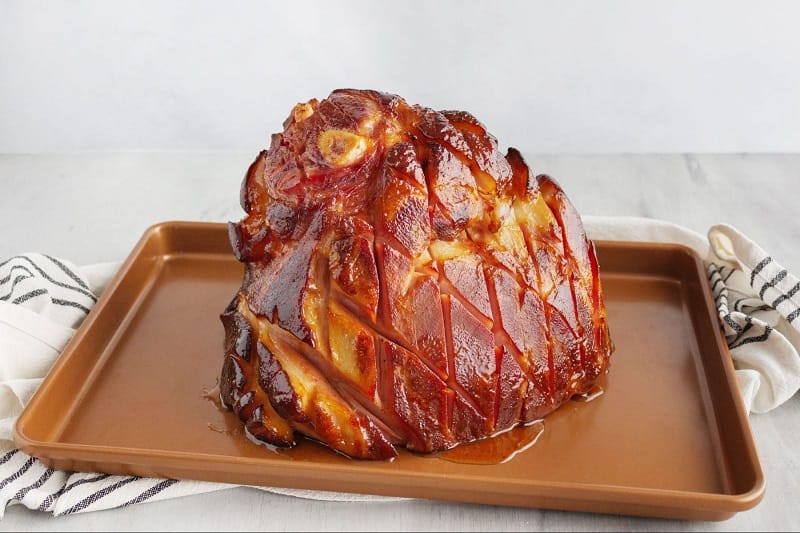In pork-centric culinary delights, two distinct cuts are versatile and flavorful – the ham hock and the ham shank. As discerning home cooks ponder the merits of these brawny porcine appendages, understanding the nuances between the two can unlock a world of rich, savory possibilities.
Origin Story – Where They Come From on the Pig
The ham hock, a humble yet indispensable ingredient in many traditional dishes, hails from the area surrounding the pig’s ankle joint. This cut primarily comprises connective tissue, skin, and a small amount of meat. Its unique textural and flavor profile differentiates it from its more muscular counterpart, the ham shank.
In contrast, the ham shank originates from the lower leg of the pig, a region that boasts a higher proportion of meat, bone, and marbling. This meatier cut offers a more balanced flavor profile and a tender, fall-off-the-bone texture when cooked to perfection, making it a versatile choice for various culinary applications.
Flavor and Texture – A Tale of Two Cuts
The ham hock’s flavor is nothing short of intense and savory, a testament to the high concentration of connective tissue and bones within the cut. This abundance of collagen and gelatin-rich elements lends a bold, almost robust taste to the hock and a chewy, gelatinous texture released during cooking. It is an indispensable ally for those seeking a powerful flavor base to anchor their soups, stews, and bean dishes.
In contrast, the ham shank offers a more nuanced and balanced flavor profile, with both meaty and savory notes seamlessly intertwined. With its optimal marbling and tender texture, this meatier cut shines when cooked using braising or slow-cooking methods, allowing the flavors to meld and the meat to fall off the bone practically.

Culinary Applications – Where They Shine
The ham hock’s intense flavor profile and gelatinous texture make it an ideal candidate for enriching broths, soups, and bean-based dishes. As the hock simmers, its savory essence infuses the entire preparation, adding a depth of simply unmatched flavor. From hearty split pea soup to comforting collard greens, it’s ability to elevate and anchor these dishes is truly remarkable.
The versatility of the ham shank is a testament to its well-rounded attributes. Whether braised low and slow until the meat is fork-tender or grilled to impart a delightful char, it adapts seamlessly to various cooking techniques. This meatier cut can be enjoyed on its own as the centerpiece of a meal, or it can be shredded and incorporated into stews, casseroles, or even sandwiches, showcasing its adaptability in the culinary realm.
Choosing Your Brawny Bite
The ham hock is an unparalleled choice for those who crave a powerful and unapologetic flavor experience. Its robust, savory essence can lend an irresistible depth to soups, stews, and bean dishes, making it an indispensable ingredient for those seeking to elevate their culinary creations.
On the other hand, for those who relish a more substantial and satisfying bite, the ham shank is sure to deliver. Its impressive meatiness and tender, fall-off-the-bone texture makes it a versatile and crowd-pleasing option.
Beyond the Basics – Substitutions and Tips
While the flavor profile may not be as intense with a ham shank substitution, the meatier texture can still lend a satisfying element to the preparation. Conversely, using a ham hock instead of a shank may result in a more concentrated, savory note, but the cooking time may need to be adjusted to account for the difference in size and composition.
Soak ham hocks in water for some time before cooking to enhance the flavor and minimize any potential bitterness. This simple step can help reduce saltiness and draw out unwanted impurities. For ham shanks, browning the meat before braising or slow-cooking can add a layer of complexity, caramelizing the exterior and intensifying the overall flavor profile.

Hey there, barbecue lovers! I’m Mike Jones, the proud owner of Austin’s Live Fire Barbecue, where we specialize in serving up mouthwatering Central Texas-style barbecue. At our restaurant, we’re all about slow-cooking our meats over open flames, infusing them with that signature smoky flavor that you can’t resist.
When you visit us, you can expect to feast on tender brisket, juicy ribs, and flavorful sausages, all cooked to perfection using traditional methods passed down through generations. We take pride in sourcing the finest cuts of meat and using our secret blend of spices to create a truly unforgettable dining experience.
